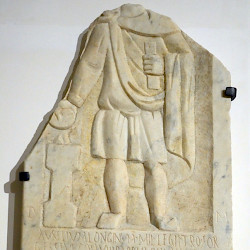Legio II Traiana Fortis
Legio II Traiana Fortis: one of the Roman legions. Its name means "the strong legion of Trajan".

This legion and XXX Ulpia Victrix were founded in 105 by the emperor Trajan,note who was fighting a war in Dacia (modern Romania) and needed reinforcements. After the annexation of Dacia, the legion was transferred, but we do not know to what place. A possible guess is that it was sent to the east, where Trajan annexed Arabia Petraea in 106. It is possible that II Traiana Fortis was the first garrison of the new province, together with III Cyrenaica. On the other hand, a stay at the Danube is likelier.
The Second Trajan legion was transferred to Syria and took part in Trajan's campaign against the Parthian Empire in 115-117 and was stationed in Judaea after this war. This province had been unquiet for some time (go here for the story).
In 125, it was transferred to Alexandria, where it shared a base with XXII Deiotariana and succeeded III Cyrenaica. (This legion, which had always been at Alexandria, had been sent to Arabia Petraea in 106, but had returned before 119. Now, it was sent to Arabia again.) In the years between 132 and 136, several subunits of the Second Trajan legion took part in Hadrian's campaign against the Jews, who had revolted under Simon ben Kosiba and had destroyed XXII Deiotariana. Other subunits must have remained at Alexandria, which had a large Jewish community and could not be left unguarded.
The Second Traian legion returned to Egypt, where it was to remain the main force. The soldiers often served outside Alexandria, for example as garrison of provincial towns in Upper Egypt. They are known to have been present at Panospolis, Thebes, Syene and Pselchis. The last-mentioned town was at the southern frontier of the Roman empire and it is likely that the legionaries controled traders coming from the Meroitic kingdom of Nubia.
It is likely that (subunits of) II Traiana Fortis took part in Lucius Verus' campaign against the Parthians (162-166). Participation in the Marcomannic wars of Verus' brother Marcus Aurelius is neither excluded nor proven. We have more certainty about the legions' role in 175, when it sided with the rebel general Avidius Cassius. His revolt, however, was unsuccessful.

Eighteen years later, II Traiana Fortis supported Pescennius Niger, a governor of Syria who wanted to become emperor. Before the decisive battle against Lucius Septimius Severus in 194, the legion changed sides and was justified in its claim that it had been Severus' "king maker". The soldiers of the Second Trajan legion had the custom of mentioning their battalion (centuria) on their tombstones. This is an almost unique habit, which is only known from II Traiana Fortis and II Parthica. It suggests that when the Second Parthian legion was founded in 197, it was made up from legionaries from Alexandria. However, there is no other evidence for this hypothesis
The emperor Caracalla gave the legion the title Germanica ("German") in 213, which proves that the entire legion had been employed in the war against the Germanic Alamanni. Half a century later, a subunit of II Traiana Fortis made the same trip to the far west, when the emperor Gallienus (260-268) demanded its support against Postumus, the ruler of the independent Gallic Empire. However, this subunit went over to the other side and returned to Egypt after Aurelian had reconquered Gaul.

A coin by the emperor Carinus (283-285) shows the eagle standard of the legion. It was still in Alexandria in 296, when the emperor Diocletian reinforced the garrison with a second legion, III Diocletiana. Two years later, a subunit seems to have fought against the Moors in Mauretania. (This is suggested by the Christian Acts of Saint Marcellus, which may at this point be unreliable.) The legion was still in the west of Lower Egypt in the fifth century.
The emblem of the second legion was the demigod Hercules. Its significance is not completely clear, but it is tempting to think that the legion's founder,Trajan, thought of himself as a new Hercules. At least one orator, Dio of Prusa, likened the emperor to the son of Jupiter.
Literature
- S. Daris, "Legio II Traiana Fortis", in: Yann Le Bohec, Les légions de Rome sous le Haut-Empire (2000 Lyon) 359-363
- B. Isaac & I. Roll, "Legio II Traiana in Judaea", in Zeitschrift für Papyrologie und Epigraphik 33 (1979) 149-156
- J. Rea, "Legio II Traiana in Judaea", in Zeitschrift für Papyrologie und Epigraphik38 (1980) 220-221
- B. Isaac & I. Roll, "Legio II Traiana in Judaea - A Reply", in Zeitschrift für Papyrologie und Epigraphik 47 (1982) 131-132
 Alexandria, Tombstone of Longinus of II Traiana |